
The squat is a compound, multi-joint exercise that mimics the basic functional movement of lowering your hips from a standing position. Despite its simplicity, the squat is one of the most effective exercises for building lower body strength and power.
The squat primarily works your quads, hamstrings and glutes. It also engages your lower back muscles and core.
Squats can be performed using your bodyweight, a loaded barbell or dumbbells or even with a resistance band.
Jump to
Squats vs other exercises
There are many exercises to choose from to target your lower body. Deadlifts, leg presses and lunges all target your quads, hamstrings and glutes. But how do squats compare to these exercises?
- Squats vs deadlifts - The deadlift, like the squat, is a compound exercises that works multiple muscle groups at once. It primarily targets your posterior chain, including your glutes, hamstrings, and lower back. But deadlifts can be risky if performed incorrectly. Poor form can put excessive strain on your lower back and lead to injury. Squats distribute the load more evenly across your lower body and encourage better posture, reducing the risk of back injuries.
- Squats vs leg press - The leg press also targets your quads and glutes, but puts less emphasis on your hamstrings when compared to the squat. Additionally, the leg press does not engage your core as much as squats do. Squats strengthen your lower body but also improve your core strength and stability.
- Squats vs lunges - Lunges also target the same muscles as squats. But because they involves a step forwards or backwards, lunges put more emphasis on your balance and coordination. The lunge position also puts more stress on your knee joints. Squats, on the other hand, allow for a more controlled movement and put less strain on your knees.
Muscles
Quads
Your quads (quadriceps) are the muscles at the front of your thighs. Their function is to straighten your knee from the bent position, and they help stabilize your knee joint. Your quads help in exercises like climbing, walking, running and jumping.
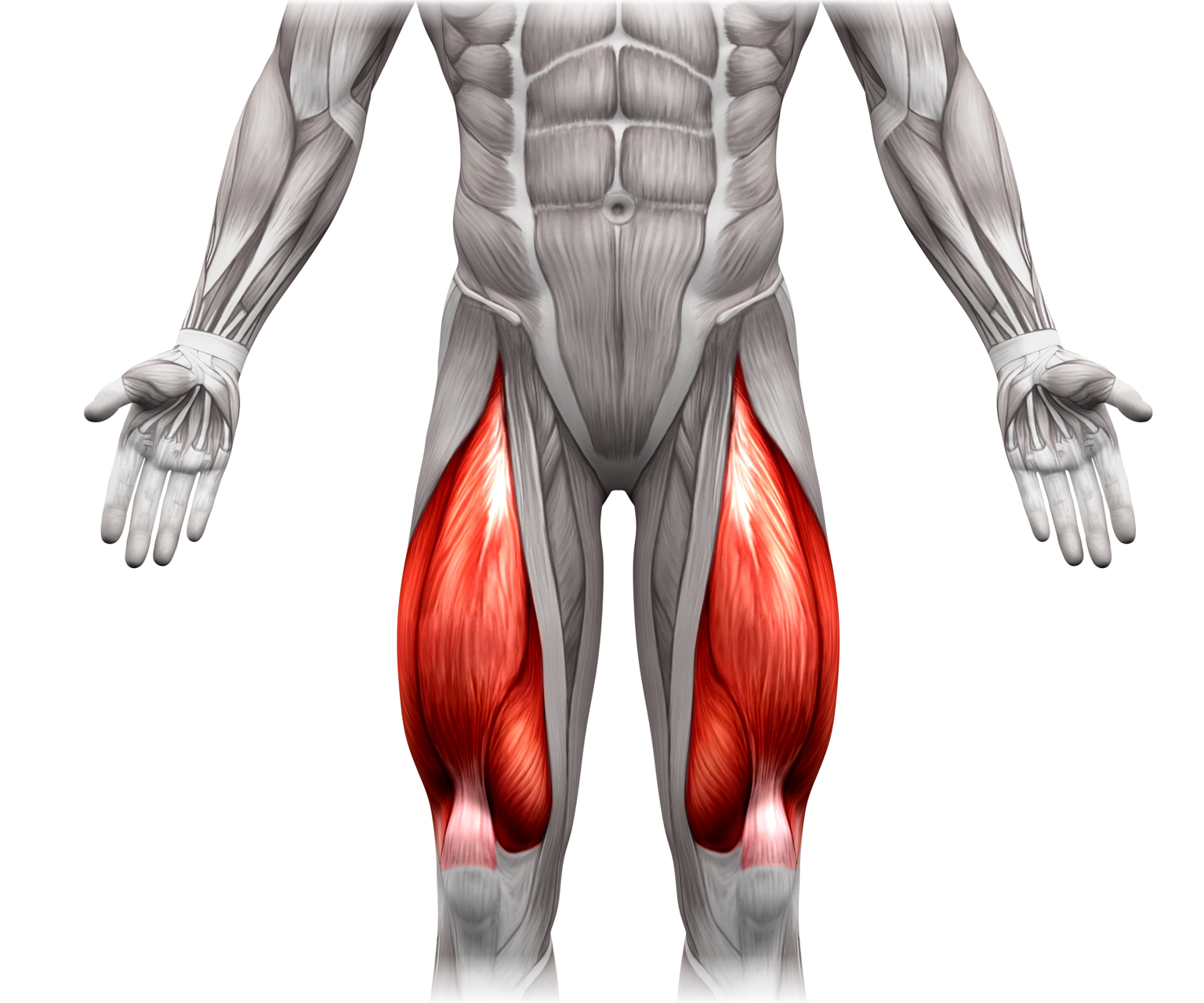
Your quads are made up of four separate muscles - vastus lateralis, vastus medialis, vastus intermedius and rectus femoris. Each of these muscles originates from a different point on your femur and hip, and connect into a quadriceps tendon that attaches to your knee cap.
The quads are a primary muscle worked by all variations of the squat. Some variations, notably the front squat, place more emphasis on your quads compared to the traditional barbell back squat.
Glutes
Your glutes are made up of three muscles in your buttock. They produce hip extension (moving your leg back), rotation and hip abduction (moving your leg out to the side), as well as provide stability to your upper body when you stand. Your glutes are key muscles in propelling your body forwards, jumping and heavy lifting.
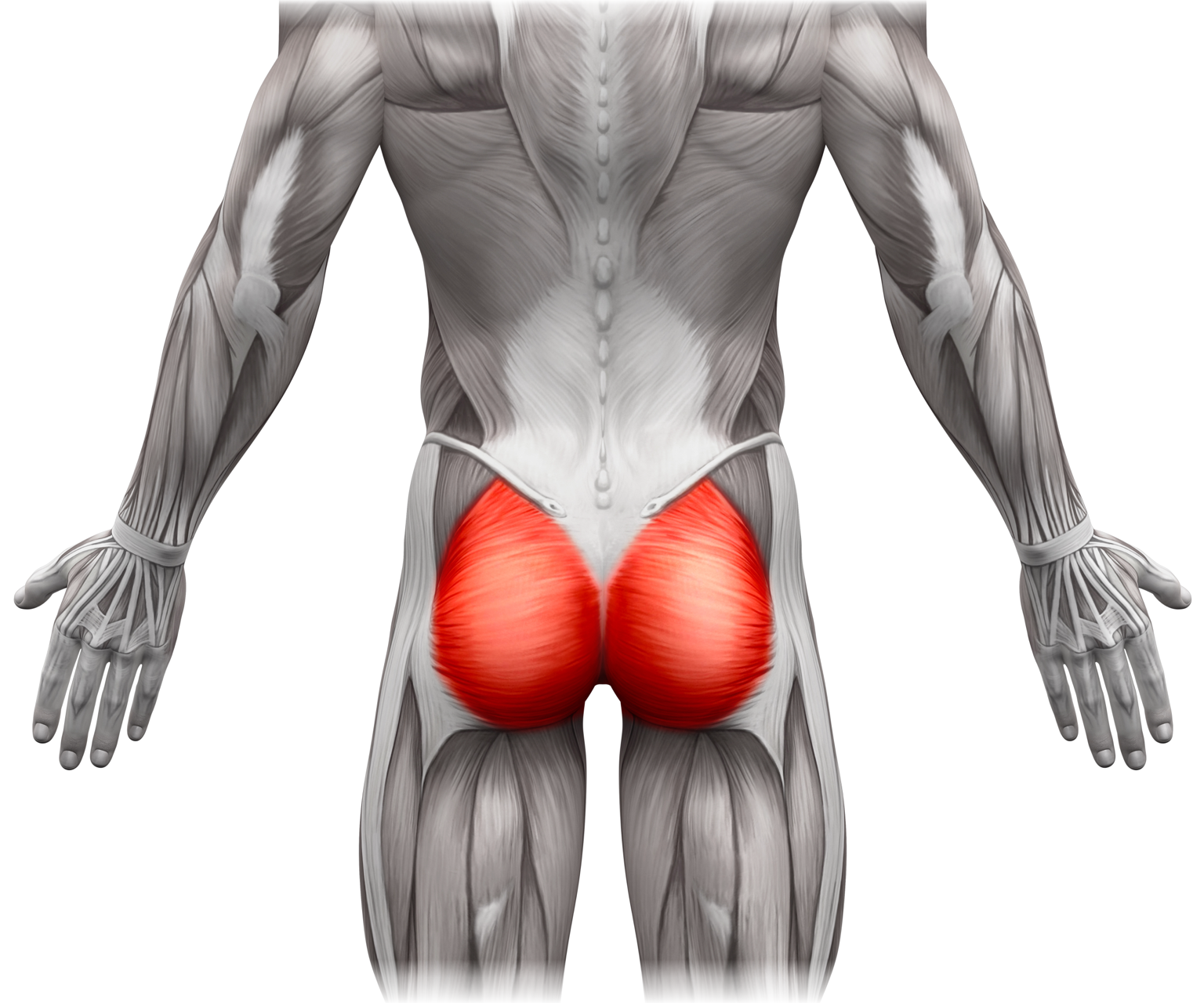
Your glutes are engaged as you stand up from a squatting position. All squats target your glutes as a primary muscle, but variations like the sumo squat can put even greater emphasis on your glutes.
Hamstrings
Your hamstrings are made up of three muscles – the biceps femoris, the semitendinosus and the semimembranosus. Together, these muscles allow your leg to bend about the knee and assist in hip extension. Strong hamstrings are beneficial in everyday activities like walking, running and jumping.
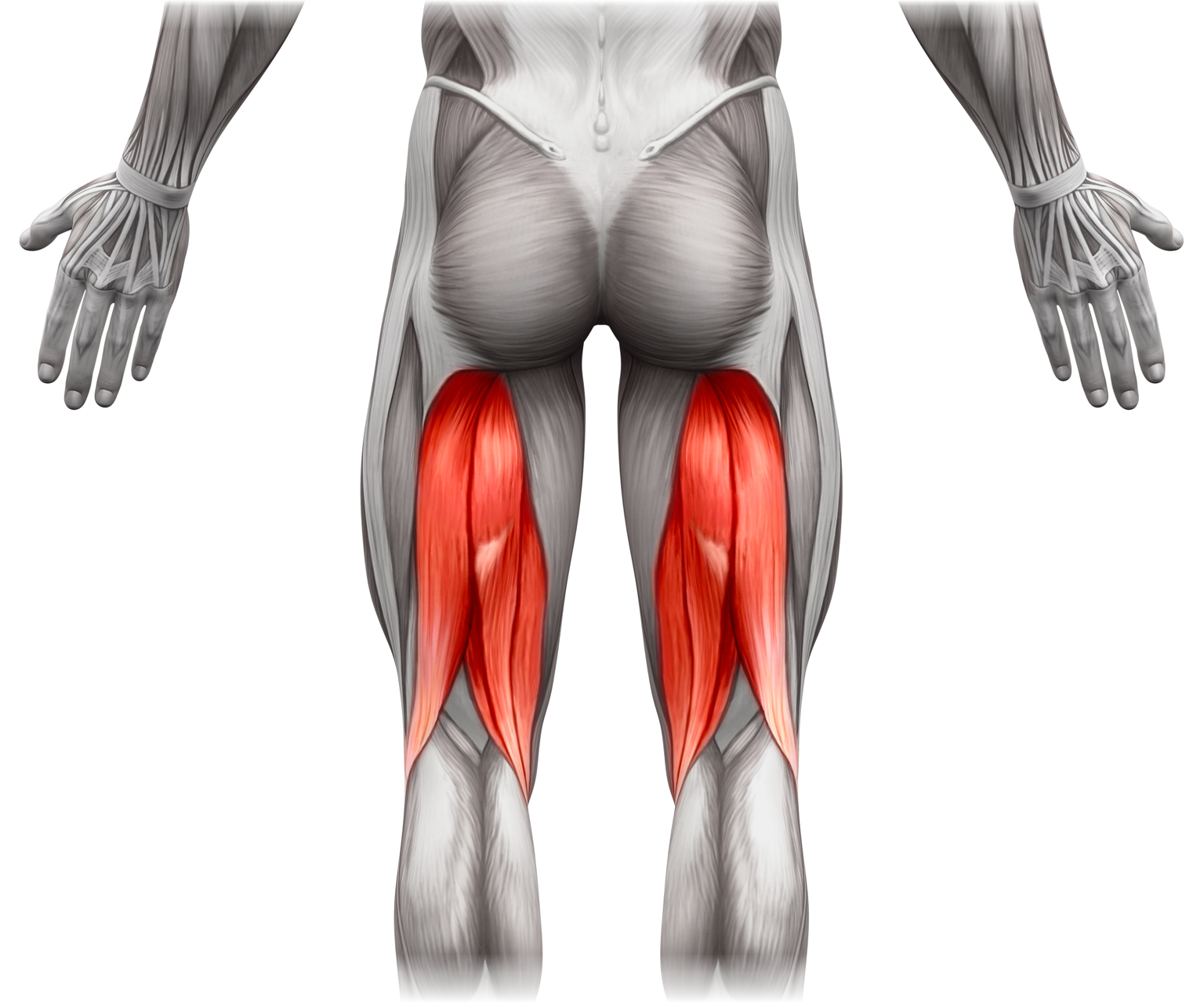
You can engage your hamstrings more by increasing your squat depth. But, although your hamstrings are engaged through the exercise, squats are not an effective way to train your hamstrings. You should also add deadlifts, lunges and/or split squats into your routine to ensure balanced development of your hamstrings.
Adductors
The adductor muscles can be found in your inner thighs. They are responsible for leg adduction (moving your legs towards your body’s center line) and stabilizing your legs in everyday activities. They also play a part in medial rotation of your thighs. Strong adductors are good for overall athletic performance and sports including baseball, golf and tennis.
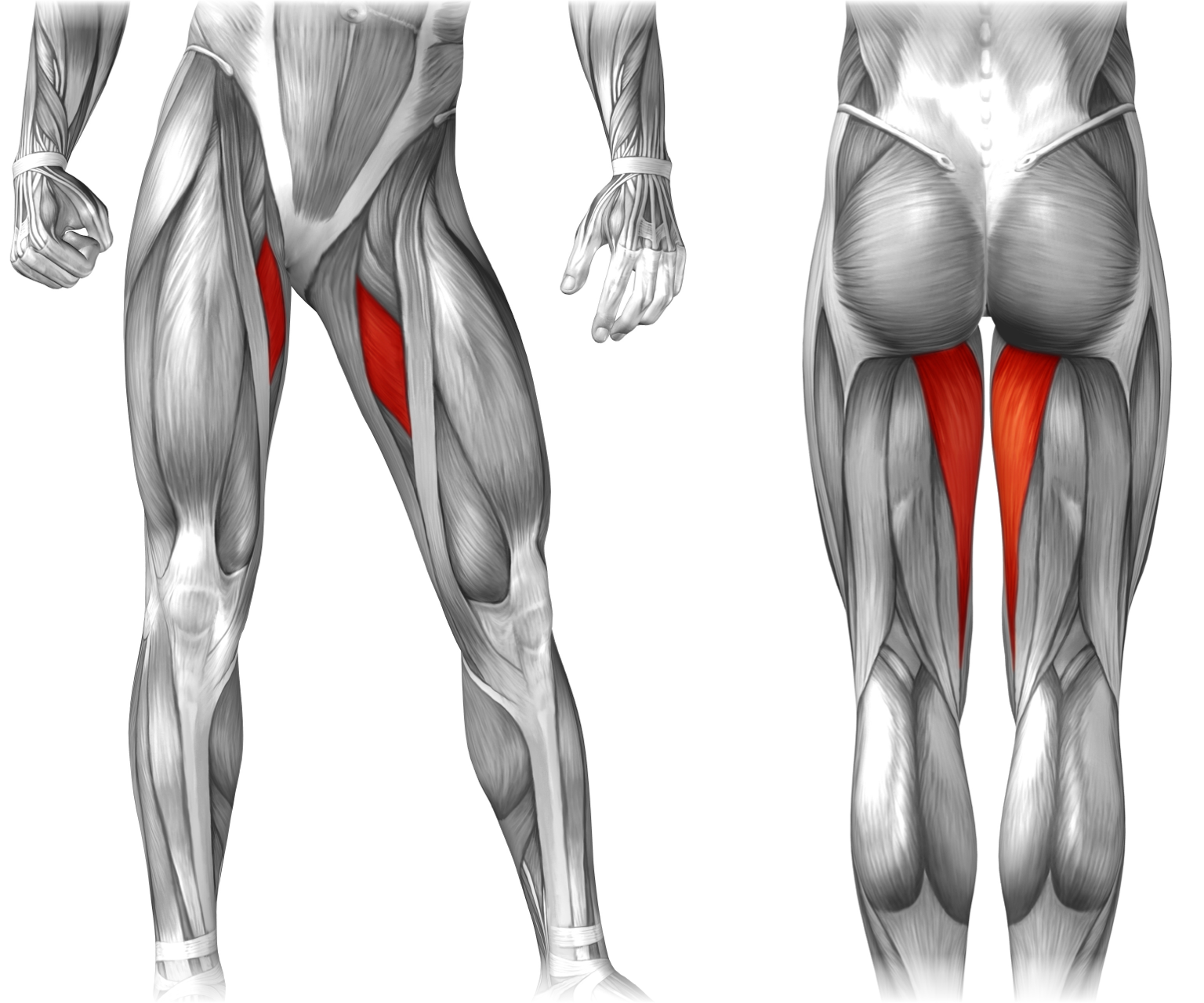
Squats performed with a wider stance, such as sumo squats, will put more emphasis on your adductor muscles.
Calf muscles
Your calf muscles are in turn made up of the gastrocnemius and soleus muscles. These muscles are essential in walking, running and jumping and provide balance and stability. When you take the tiptoe position, your calf muscles contract to pull up your heels (pointing your foot downwards, i.e. plantar flexion), shifting your bodyweight onto the ball of your foot.
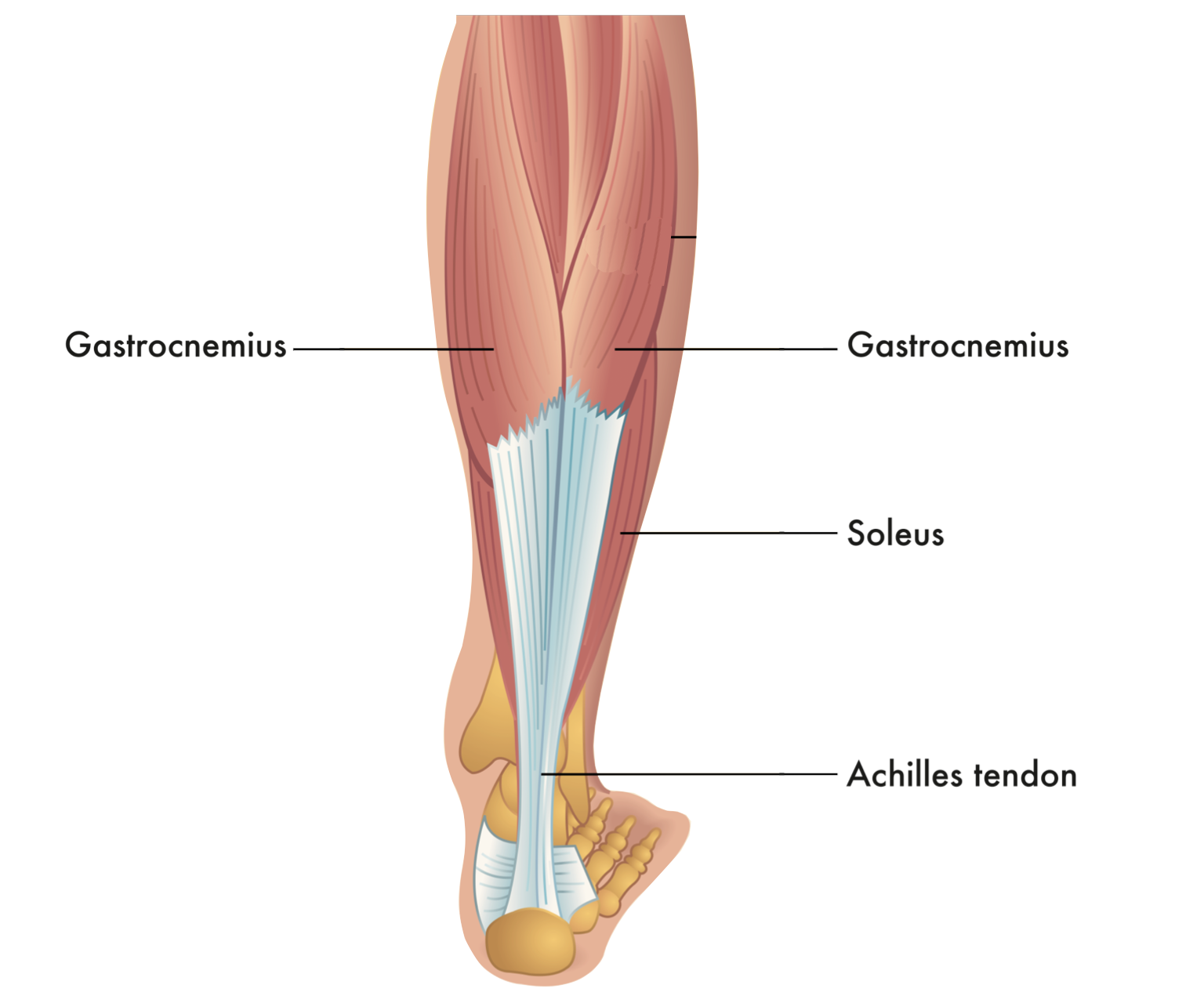
All variations of squat will stretch your calf muscles to a limited extent. It's important to note however that this isn't sufficient, so you still need to include calf raises in your workout routine to strengthen your calves and avoid injury.
Bodyweight squat
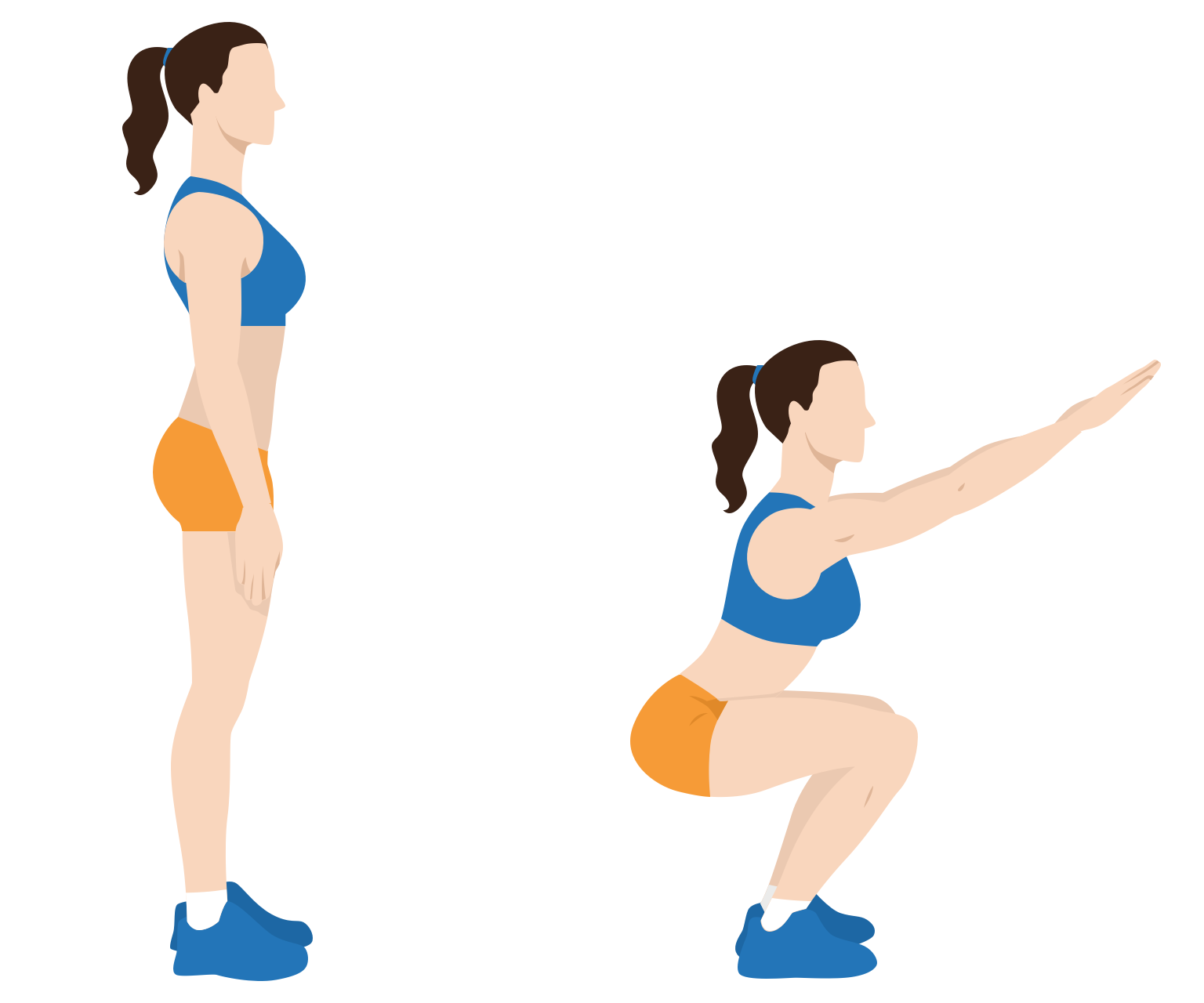
Squats are a compound exercise that work multiple lower body muscle groups at the same time. This includes your quads, glutes and hamstrings. Squats also engage your core muscles to provide stability during the movement. This makes it an extremely effective lower body exercise.
Bodyweight squats are a great place for beginners to start. Using your own bodyweight reduces the risk of injury. Once you've mastered the proper form, you can advance to the other variations that add more weight/resistance to the exercise.
Squats make a great addition to your leg day or full body workout routine. Since bodyweight squats need no equipment, it's a great exercise to do when following an at-home workout plan.
How to
- Stand up straight with your feet hip-width apart.
- Push your hips back and bend your knees as if you were sitting on a chair. Keep your chest up and stretch out your arms to maintain balance.
- Lower down into the squat as far as is comfortable. Make sure your knees do not drift beyond your toes.
- Pause for the moment at the bottom of the movement.
- Finally, push through the heels of your feet to stand back in the starting position.
- Repeat for the desired number of reps.
Sets and reps
The number of sets and reps for the squat depends on your fitness goals, and the design of your workout routine. A general guideline is to do 3-4 sets of 3-5 reps to develop strength/power. You can increase this to 8-12 reps if your goal is hypertrophy (muscle size).
Doing high reps of squats is fairly pointless for weightlifting. Really, you will only consider high rep squats if you perform sports like cycling where you can benefit from endurance rather than power.
You should generally program squats early in your workout, because they are a compound exercise hitting multiple muscle groups. This will allow you to pre-exhaust your lower body muscles before you conduct other, more isolating exercises.
Wall sits
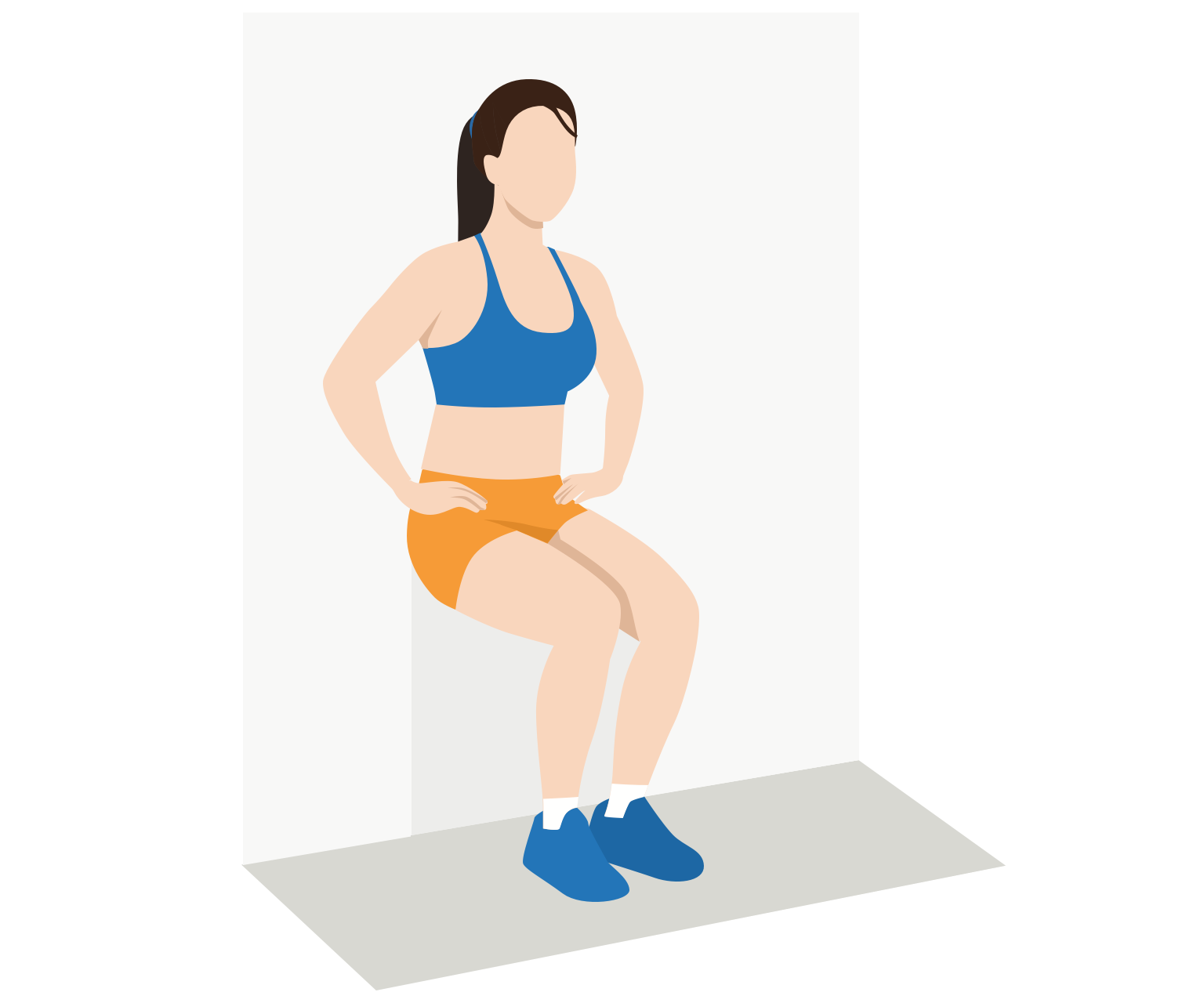
Wall sits primarily work your quads, hamstrings and glutes, but they also engage your core, helping to improve your overall balance and stability. Because wall sits use the wall for support, they allow for a more controlled movement. This makes it easier for beginners to maintain proper form compared to bodyweight squats.
You can do wall sits as part of your lower body workout if you find bodyweight squats too difficult. They also work well as part of a 10 minute wall pilates workout - another great way to workout from home!
Rather than pausing for 1 second at the bottom of the movement, you can more easily pause for 20-30 seconds because you have the support of the wall. This will increase the time under tension for your leg muscles, leading to more strength over time.
How to
- Stand with your back against a flat wall. Place your feet shoulder-width apart.
- Position your feet forwards until you are able to take a sitting position with your knees bent at a 90-degree angle. If you have the correct form, your knees will be directly above your ankles and will not extend beyond your toes.
- Hold for 20 seconds in this position, then push up by straightening your legs.
- Rest for 30 seconds, then repeat.
Barbell squat
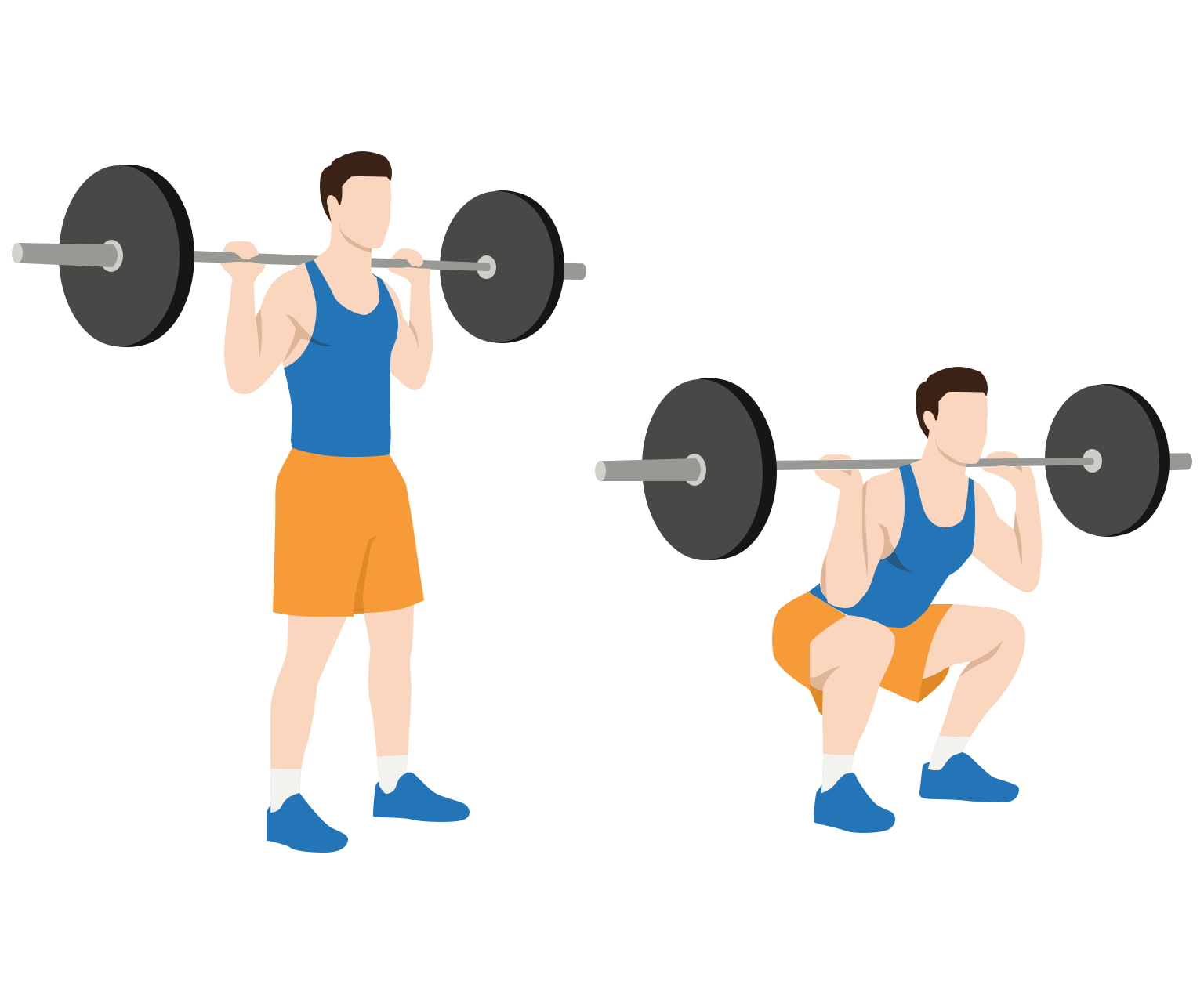
The barbell squat adds more resistance to the exercise. This in turn places a greater demand on your muscles and allows for enhanced strength and muscle growth.
With any squat, it's important to maintain proper form to avoid injury and maximize the effectiveness of the exercise. So only use a weight that you can manage comfortable for the entire rep range.
The barbell squat is one of the best compound exercises for leg day. It builds your lower body strength and muscle mass, as well as improving your balance and coordination skill.
How to
- Stand up straight with your feet shoulder-width apart.
- Lift a barbell over and behind your back, so that it rests on your upper back (holding with both hands).
- Push your hips back and bend your knees as if you were sitting on a chair. Keep your chest up and pull your shoulders back.
- Lower down into the squat as far as is comfortable. Make sure your knees do not drift beyond your toes.
- Pause for the moment at the bottom of the movement.
- Finally, push through the heels of your feet to stand back in the starting position.
- Repeat for the desired number of reps.
Front squat
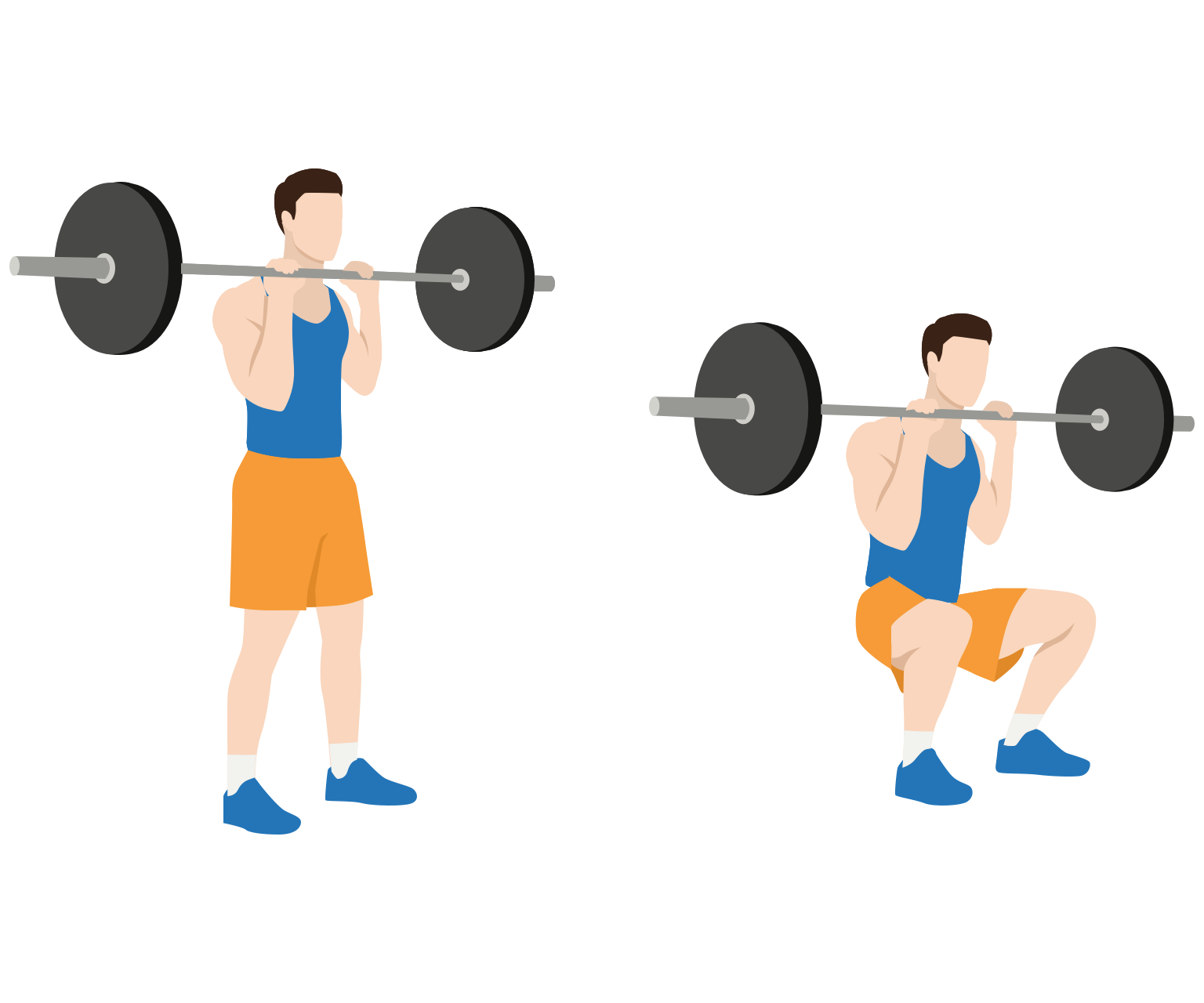
In the front barbell squat, you hold the barbell in front of your shoulders, rather than placing it on your back. This shift in weight changes the focus of the exercise away from your posterior chain and more towards your anterior chain (quads and core).
The front squat is particularly beneficial if you want to address imbalances caused by overtraining with posterior chain exercises.
How to
- Stand up straight with your feet shoulder-width apart.
- Lift a barbell up to rest in front of your shoulders, holding it with your palms facing outwards. Your elbows should be pointed forwards.
- Push your hips back and bend your knees as if you were sitting on a chair. Keep your chest up and pull your shoulders back.
- Lower down into the squat as far as is comfortable. Make sure your knees do not drift beyond your toes.
- Pause for the moment at the bottom of the movement.
- Finally, push through the heels of your feet to stand back in the starting position.
- Repeat for the desired number of reps.
Dumbbell squat
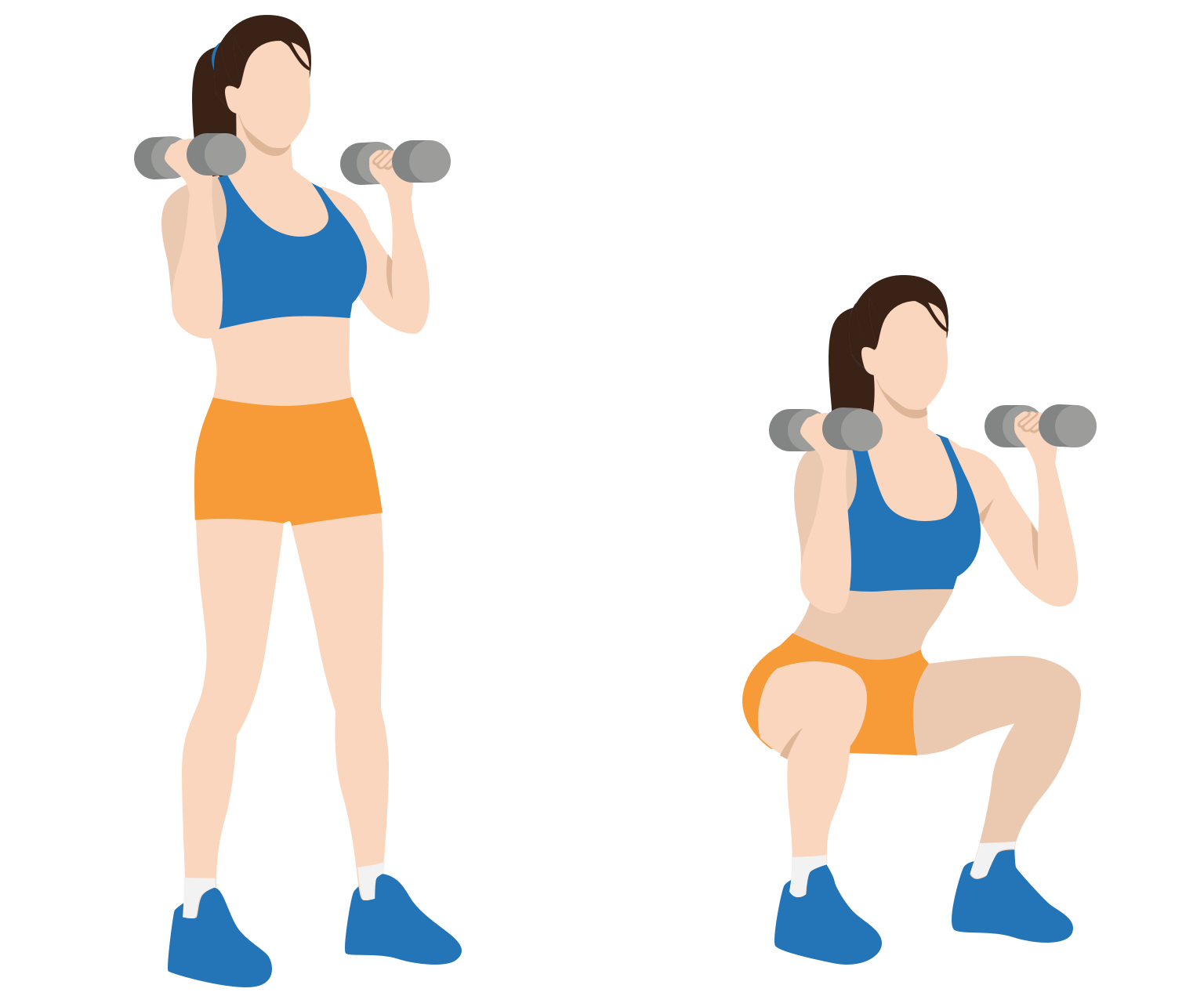
In a dumbbell squat, the weight is held at your sides, so there is no load being transferred into your upper back. This can make the exercise more accessible to those with back issues, but it can also be more challenging since it demands core strength and lower body stability during the movement.
This variation is a great way to improve your balance and coordination. It can also help you address imbalances because you are working with independent weights.
How to
- Stand up straight with your feet shoulder-width apart.
- Lift a pair of dumbbells up in front of your shoulders, holding them with your palms facing inwards.
- Push your hips back and bend your knees as if you were sitting on a chair. Keep your chest up and pull your shoulders back.
- Lower down into the squat as far as is comfortable. Make sure your knees do not drift beyond your toes.
- Pause for the moment at the bottom of the movement.
- Finally, push through the heels of your feet to stand back in the starting position.
- Repeat for the desired number of reps.
Goblet squat
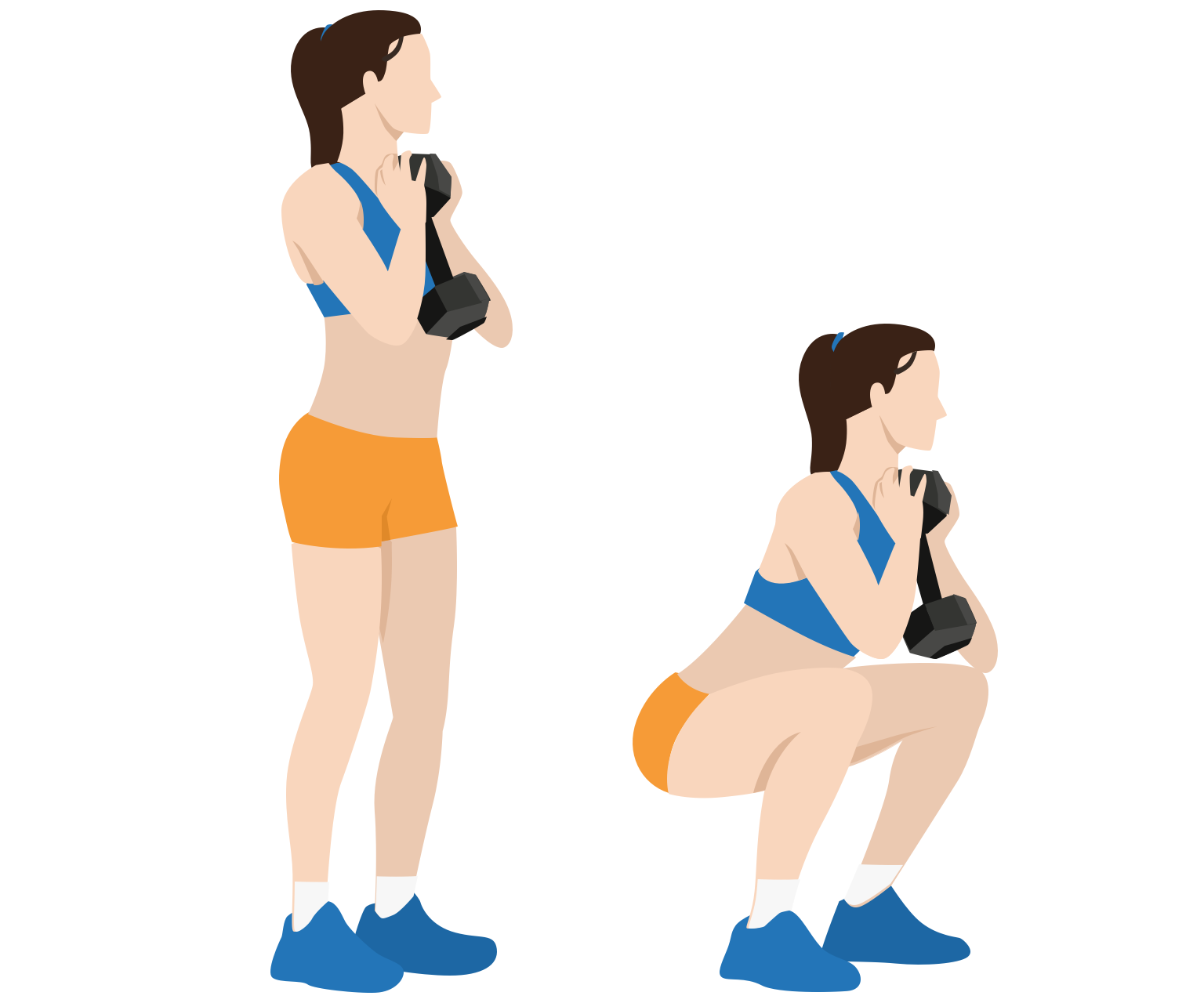
The goblet squat can be performed by holding a single dumbbell or kettlebell close to the center of your chest. This means no weight is being loaded directly onto your back.
This variation of the exercise can be easier to perform than dumbbell squats because the weight is held centrally. This means you need less balance skill to perform the squat with good form.
How to
- Stand up straight with your feet slightly wider than shoulder-width apart.
- Hold a dumbbell or kettlebell in front of your chest.
- Push your hips back and bend your knees as if you were sitting on a chair. Keep your chest up and pull your shoulders back.
- Lower down into the squat as far as is comfortable. Make sure your knees do not drift beyond your toes.
- Pause for the moment at the bottom of the movement.
- Finally, push through the heels of your feet to stand back in the starting position.
- Repeat for the desired number of reps.
Sumo squat
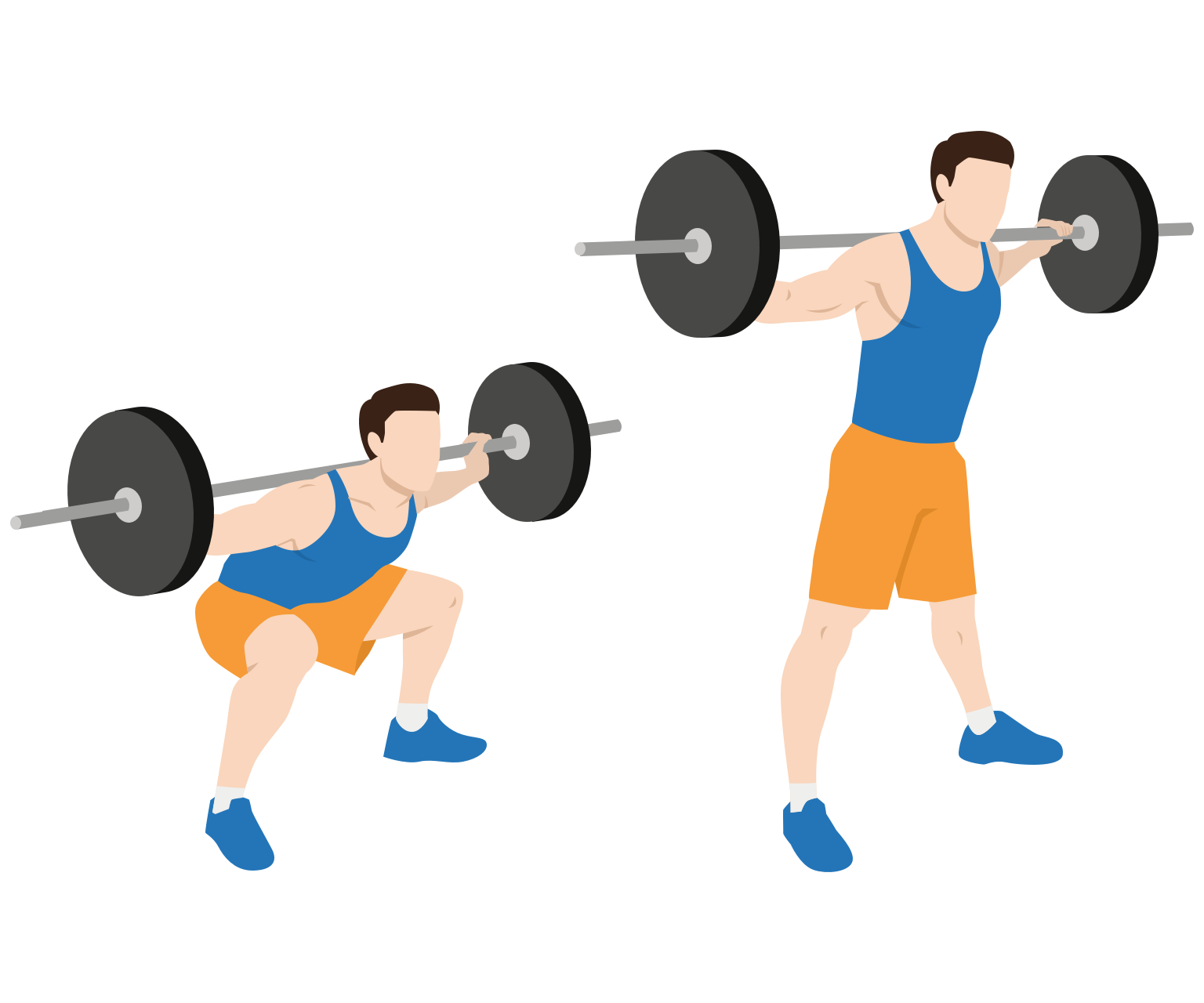
In the wide-stance sumo squat, you place your feet wider apart with your toes pointing outwards. Compared to the traditional squat, this puts more emphasis on your inner thighs and glutes, and less emphasis on your quads.
How to
- Stand up straight with your feet spread wide. Your toes should be pointing out.
- Lift a barbell over and behind your back, so that it rests on your upper back (holding with both hands).
- Push your hips back and bend your knees as if you were sitting on a chair. Keep your chest up and pull your shoulders back.
- Lower down into the squat as far as is comfortable. Make sure your knees do not drift beyond your toes.
- Pause for the moment at the bottom of the movement.
- Finally, push through the heels of your feet to stand back in the starting position.
- Repeat for the desired number of reps.
Resistance band squat
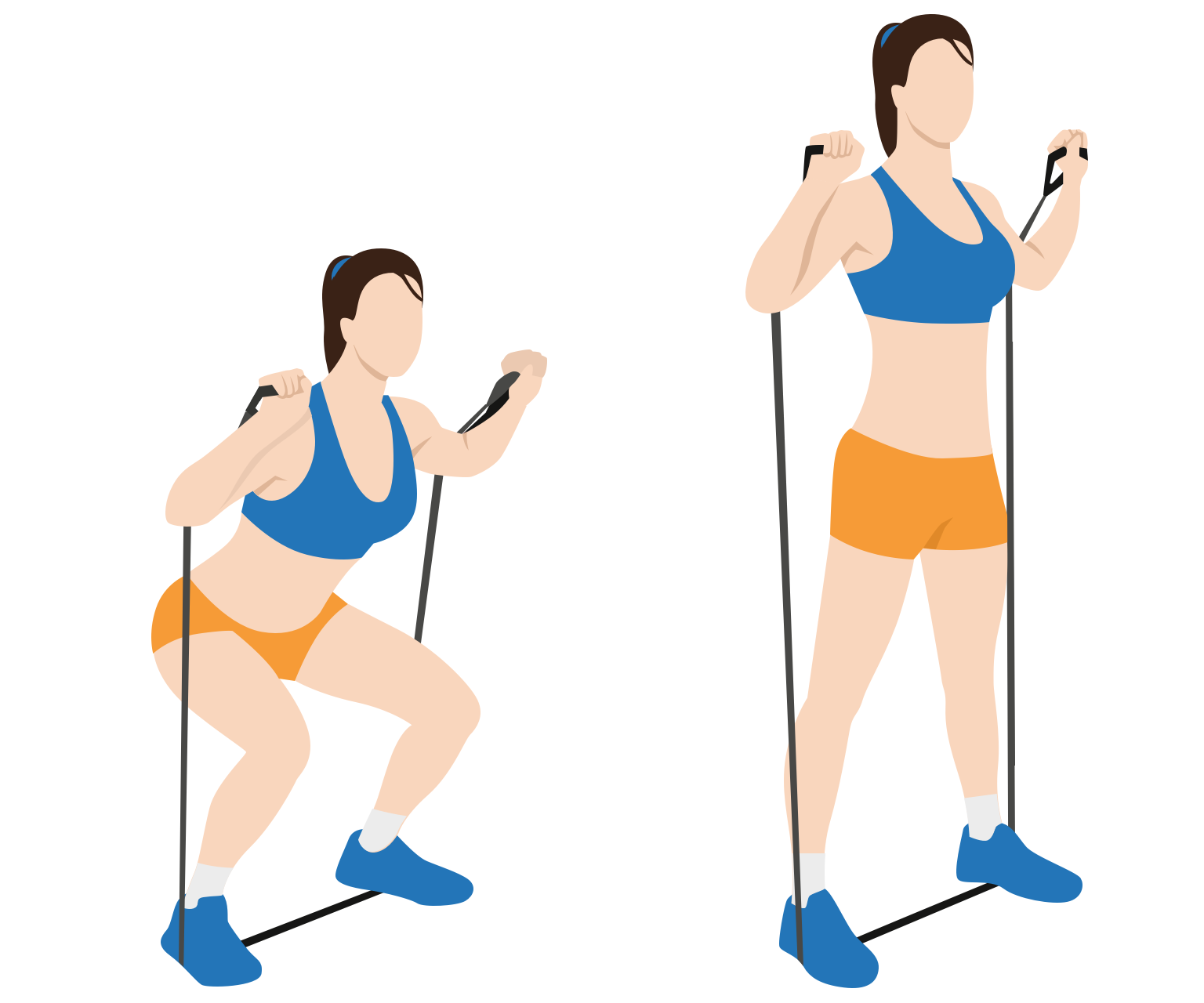
The resistance band squat is a good alternative the bodyweight squat, adding an additional challenge to the exercise. Resistance bands increase the resistance when they are stretched. This makes the exercise more challenging as you push out of the squat.
This variation also encourages you to keep your knees aligned with your toes during the movement, making it easier to maintain proper form through the movement.
How to
- Step onto a resistance band with your feet about shoulder-width apart.
- With your elbows pointed out, hold both ends of the resistance band so that band travels behind your upper arm. Your palms should be facing outwards.
- Lower your body into the squat position, keeping your chest up. Ensure your knees do no extend beyond your toes.
- Pause for a second at the bottom of the movement.
- Finally, push back through your heels against the resistance until you are standing upright again.
- Repeat for the desired number of reps.
Jump squat
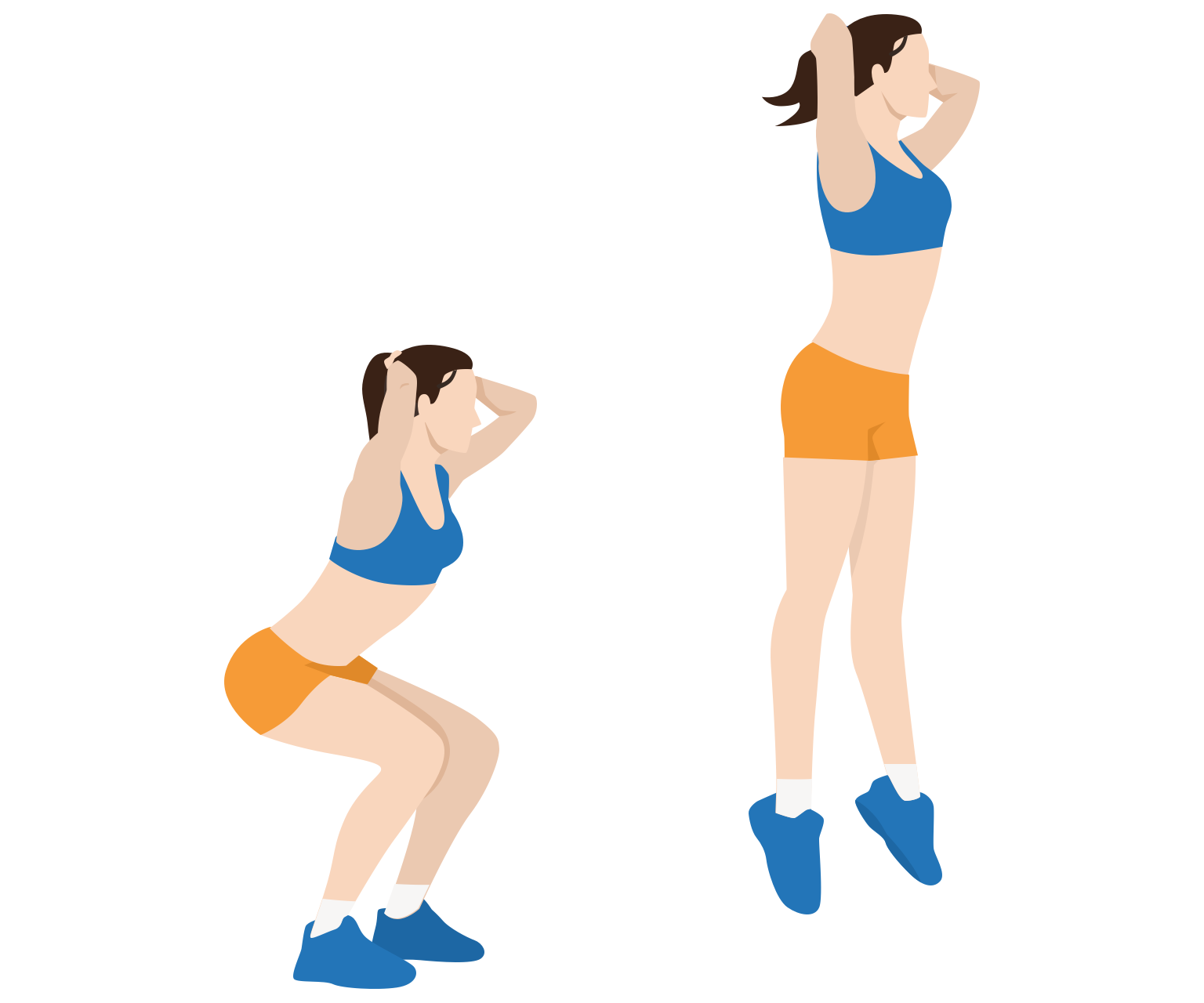
The jump squat combines the bodyweight squat with a powerful jump movement from the squatted position. This variation not only develops your power, but it adds a high-intensity cardio element to your workout.
This exercise is a good option for athletes who play sports that need explosive leg power - for example basketball or volleyball.
How to
- Stand with your feet shoulder-width apart and your toes facing directly forwards.
- Lower your body into the squat position by bending your knees and hips back as if sitting in a chair. Ensure your knees are positioned above your toes.
- From the squat position, jump up by pushing off the balls of your feet. You can swing your arms for additional momentum if you prefer.
- As you land, fall in a controlled motion back into the squat position. Use this movement to absorb the impact of landing through your leg muscles.
- Repeat for 5-10 minutes.
Squat jacks
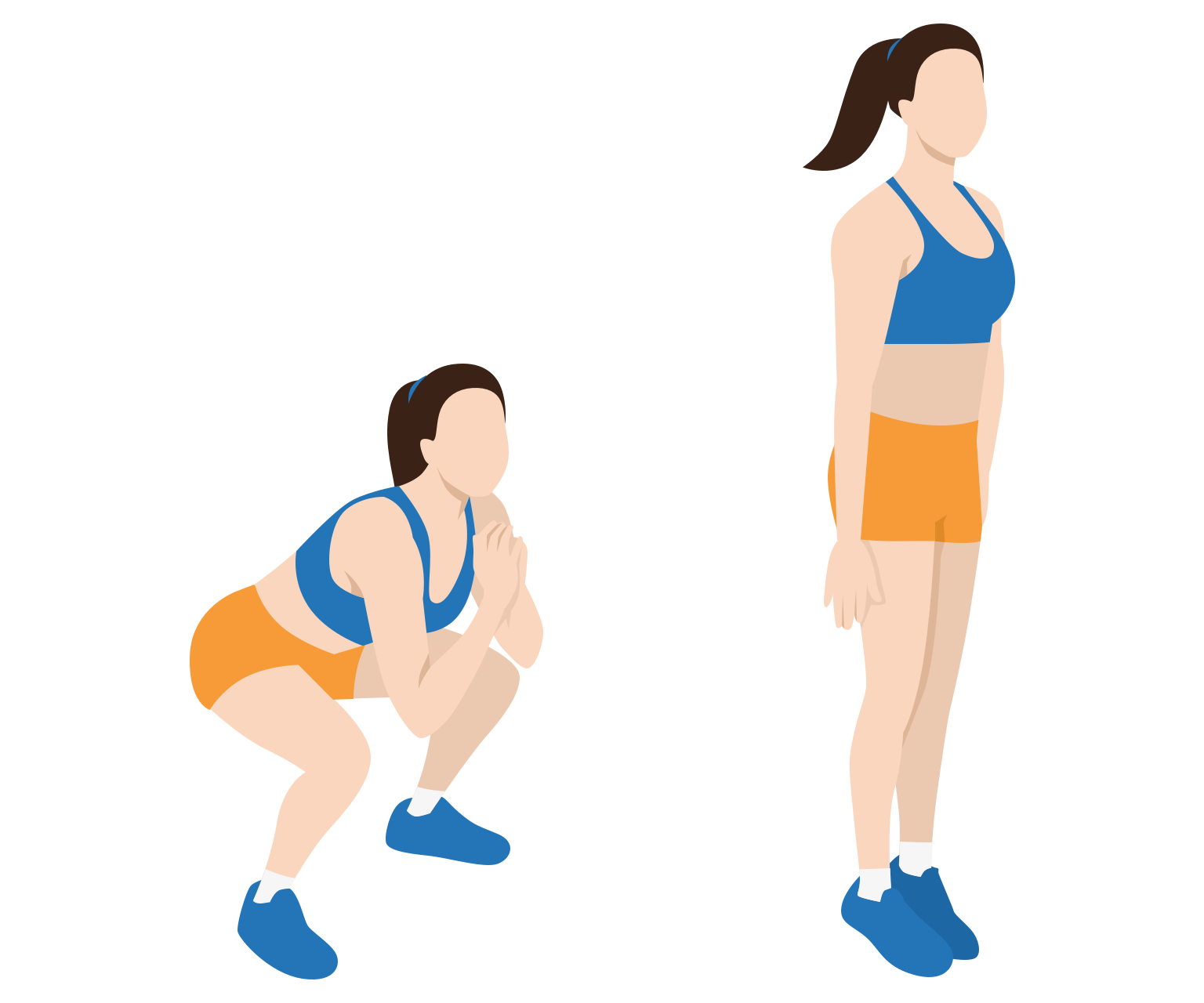
Squat jacks are similar to jump squats, although you don't project yourself fully off the ground in this variation.
The stance of your legs is also much wider in squat jacks. Whereas in jump squats you are essentially projecting your body up and down, in squat jacks you are also switching between a standing (narrow) and wide squat stance as you alternate between the two positions.
How to
- Stand up straight with your feet together.
- Jump up and out to the sides, taking on a wide stance.
- As you land, fall into a wide-stance squat, bringing your arms down to maintain balance. Keep your chest and back straight.
- Push through your heels to jump back up, bringing your feet back together. As you do this, swing your arms above your head for momentum.
- Jump your feet back out to the wide stance and repeat.
- Repeat for the desired number of reps.
Tips
Use a squat rack
Before you start, you should ALWAYS squat in a squat rack, or a power rack or cage, to make the exercise that little bit safer. You should also ensure that the bar is racked up low enough so that you need to duck down slightly to get it into position.
To get the bar into position, maneuver your body so that the bar is set up at the base of your neck, across the top of your trap muscles. Try to squeeze your shoulder blades together so that they create a cushion so that the bar feels more comfortable. You’ll need to grip the bar around 4 – 6 inches than shoulder width apart with your hands, ensuring that you maintain a firm grip.
Unracking the bar is arguably the most important aspect of squatting, as if you make a mistake, it can throw off your balance, putting the entire lift, and your safety at risk. Begin by keeping your hands and feet in the same position on and under the bar, as what we instructed previously. Ensure you keep your posture tight and the bar firmly positioned across your upper back as instructed. Next, take a deep breath and hold it, before unracking the weight from the hooks. Take a few moments to ensure the weight is stable and secure and that it is manageable and not too heavy. If it feels uncomfortable or too heavy, re-rack the weight and go lighter. If you’re happy with the weight, slowly take a few steps back away from the rack or cage, and then release your breath.
Proper form
Here are some tips for maintaining proper form while performing the squat:
- Keep your chest up and back straight - Keeping your chest up and back straight not only protects your spine, it also ensures the exercise is effectively working your lower body muscles.
- Don't let your knees go beyond your toes - This tip can help prevent strain on your knees. It can also help ensure you're using your glutes and hamstrings effectively, rather than relying too much on your quadriceps.
References
Kubo, K., Ikebukuro, T. and Yata, H., 2019. Effects of squat training with different depths on lower limb muscle volumes. European journal of applied physiology, 119(9), pp.1933-1942.
